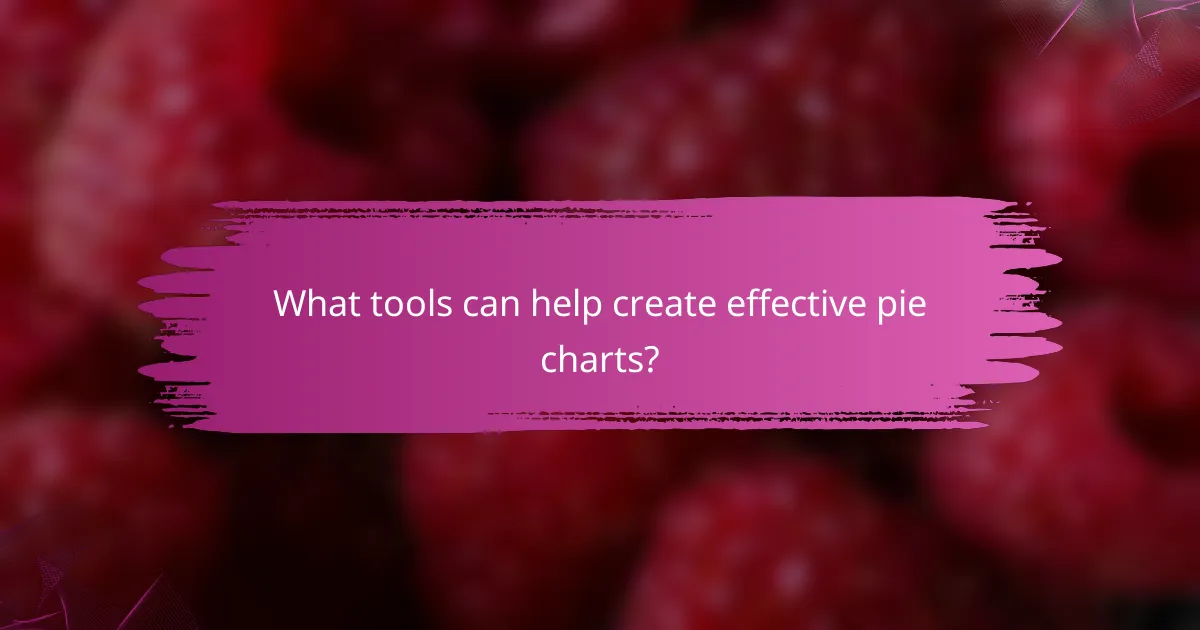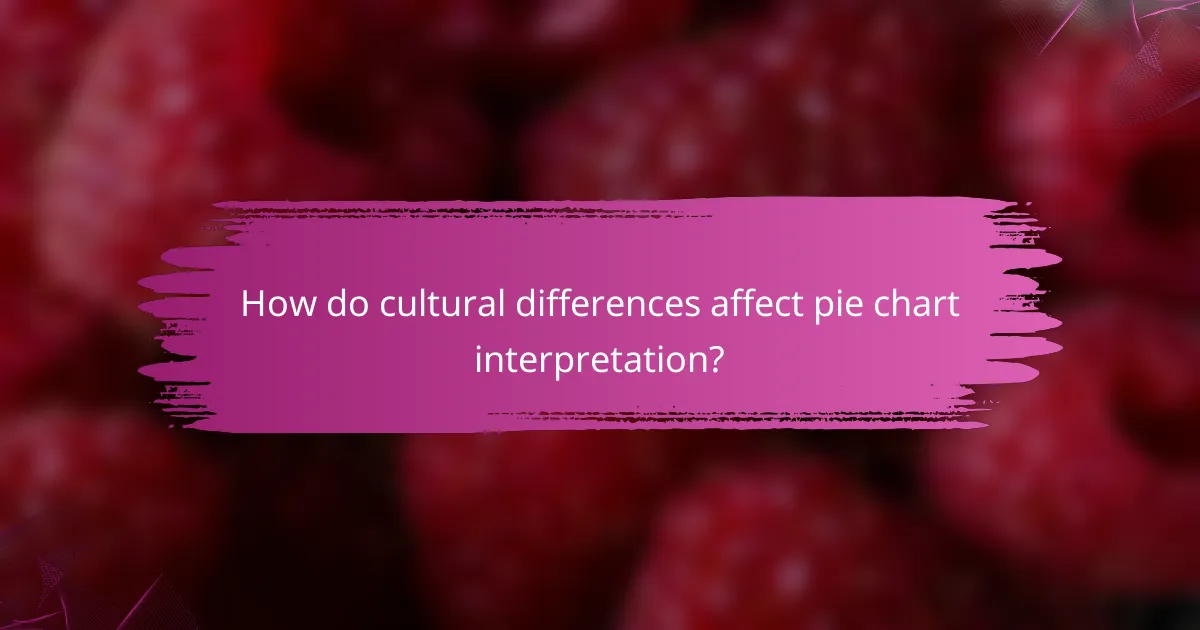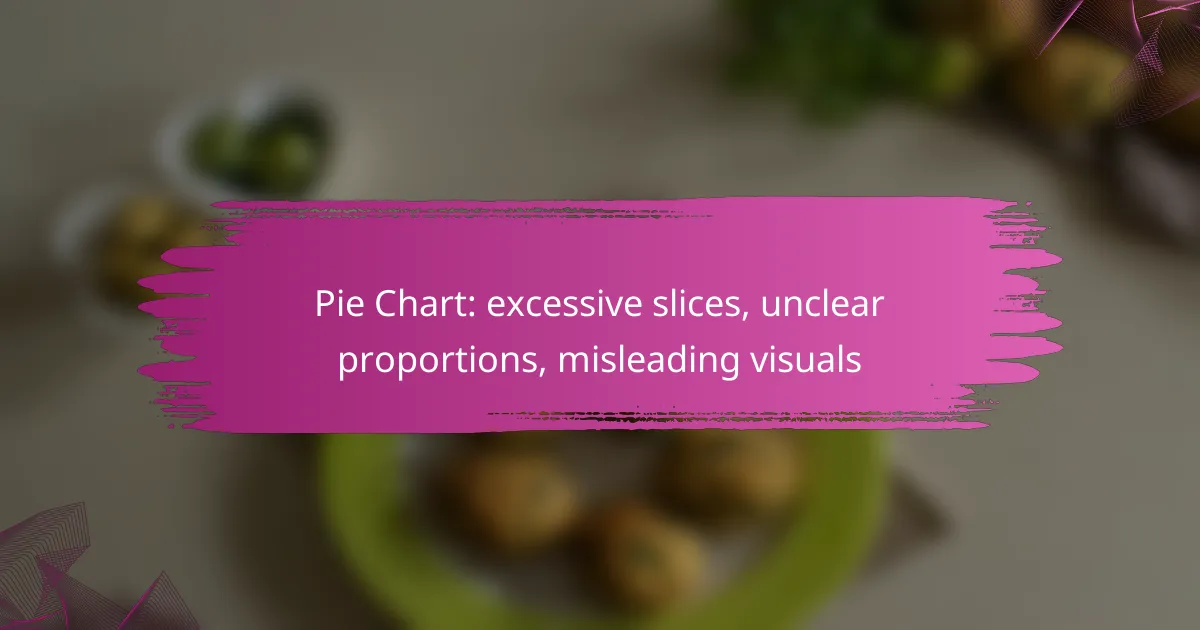Pie charts can often become confusing when they contain excessive slices, leading to unclear proportions and potentially misleading visuals. To enhance clarity, it’s essential to simplify these charts by reducing complexity and using clear color coding and informative labels. By addressing these common pitfalls, you can improve data representation and support better decision-making.

How can I simplify pie charts for better clarity?
Simplifying pie charts enhances clarity by making the data easier to interpret. Focus on reducing complexity through fewer slices, clearer color coding, and informative labels to avoid misleading visuals.
Reduce the number of slices
Limiting the number of slices in a pie chart can significantly improve its readability. Aim for no more than five to seven slices to ensure that each segment is distinguishable and meaningful.
If you have more categories, consider grouping smaller segments into an “Other” category. This approach helps to maintain the chart’s effectiveness without overwhelming the viewer with excessive detail.
Use color coding for clarity
Color coding is essential for differentiating slices in a pie chart. Use a consistent color palette that is visually appealing and easy to understand, ensuring that each color corresponds to a specific category.
Be mindful of color blindness; select colors that are distinguishable for all viewers. Tools and resources are available to help choose color schemes that enhance accessibility.
Incorporate labels for key data
Adding labels directly on or near the slices provides immediate context for the data represented. Include the category name and percentage or value to give viewers a clear understanding of what each slice represents.
For better clarity, avoid cluttering the chart with too much text. Instead, focus on key data points that will help the audience grasp the main insights quickly.
Utilize alternative chart types
Sometimes, pie charts may not be the best choice for data representation. Consider alternative chart types, such as bar charts or stacked area charts, which can convey the same information more effectively.
Bar charts, for instance, allow for easier comparison of values across categories, making trends and differences clearer to the audience. Evaluate the data’s nature and choose the chart type that best serves your communication goals.

What are the common pitfalls of pie charts?
Common pitfalls of pie charts include excessive slices, unclear proportions, and misleading visuals. These issues can distort data representation and lead to poor decision-making.
Excessive slices lead to confusion
When a pie chart contains too many slices, it becomes difficult for viewers to interpret the information accurately. Ideally, a pie chart should have no more than five to seven slices to maintain clarity.
For example, if a chart displays over ten categories, consider using a bar chart instead. This alternative can present the data more clearly and allow for easier comparisons.
Unclear proportions misrepresent data
Pie charts rely on visual proportions to convey data, but unclear proportions can mislead the audience. If the differences between slices are minimal, it may be hard to discern which category is larger or smaller.
To avoid this, ensure that the largest slice is significantly larger than the others, ideally at least 20% of the total. If no slice meets this threshold, reconsider using a pie chart.
Misleading visuals affect decision-making
Misleading visuals in pie charts can lead to incorrect conclusions and poor decisions. For instance, using 3D effects or distorted angles can exaggerate or minimize the size of slices, altering perception.
To maintain accuracy, use flat, 2D pie charts without embellishments. Always label slices clearly and consider including a legend for better understanding.

How can I choose the right chart type for my data?
Selecting the appropriate chart type is crucial for effectively communicating your data. Consider factors such as data complexity, audience understanding, and the specific message you want to convey to ensure clarity and accuracy.
Assess data complexity
Understanding the complexity of your data is the first step in choosing the right chart type. If your data consists of a few categories with clear differences, a simple bar or pie chart may suffice. However, for datasets with many variables or intricate relationships, more sophisticated visualizations like scatter plots or line graphs may be necessary.
For example, if you have data with more than five categories, a pie chart can become cluttered and difficult to interpret. In such cases, consider using a bar chart to present the information more clearly.
Consider audience understanding
Your audience’s familiarity with different chart types plays a significant role in your selection. If your audience is not well-versed in data interpretation, simpler charts with fewer elements are preferable. Aim for visualizations that convey information at a glance without requiring extensive explanation.
For instance, if presenting to a general audience, avoid technical jargon and opt for straightforward visuals. Conversely, if your audience consists of data professionals, you can use more complex charts that provide deeper insights.
Evaluate the message you want to convey
Determine the key message you wish to communicate with your data. Different chart types emphasize various aspects of the data, so choose one that aligns with your goal. For example, if you want to show proportions, a pie chart may be suitable, but if you aim to highlight trends over time, a line graph would be more effective.
Additionally, consider how the visual will be interpreted. Misleading visuals can distort the intended message, so ensure that the chart accurately represents the data. Avoid excessive slices in pie charts, as they can obscure true proportions and lead to confusion.

What tools can help create effective pie charts?
Effective pie charts can be created using various tools that offer features for clarity and interactivity. Selecting the right tool depends on your specific needs, such as ease of use, integration capabilities, and the level of detail required in the visuals.
Tableau for interactive visuals
Tableau is a powerful tool for creating interactive pie charts that allow users to explore data dynamically. It supports complex datasets and offers features like filtering and drill-down capabilities, which enhance user engagement and understanding.
When using Tableau, consider the audience’s needs. Ensure that the pie chart does not have excessive slices, as this can lead to confusion. Aim for a maximum of five to seven segments to maintain clarity.
Google Charts for web integration
Google Charts provides an easy way to create pie charts that can be embedded in web pages. It offers a variety of customization options and is particularly useful for developers looking to integrate visuals into web applications.
Keep in mind that Google Charts is best for straightforward datasets. Avoid overly complex data representations, as this can mislead viewers. A clear legend and labels are essential for effective communication.
Microsoft Excel for basic charts
Microsoft Excel is widely used for creating basic pie charts, making it accessible for most users. It allows for quick data entry and straightforward chart generation, suitable for simple presentations and reports.
When using Excel, be cautious of the default settings that may lead to misleading visuals, such as 3D effects or excessive slices. Stick to 2D charts with clear labels to ensure the proportions are easily understood.

How do cultural differences affect pie chart interpretation?
Cultural differences significantly influence how people interpret pie charts, particularly in terms of color associations and data presentation preferences. Understanding these variations is crucial for effective communication of data across diverse audiences.
Color meanings vary across cultures
Colors carry different meanings in various cultures, which can lead to misinterpretation of pie charts. For example, while red may signify danger or loss in some cultures, it can represent prosperity and good fortune in others. When designing pie charts for international audiences, consider using neutral colors or providing a legend that explains color choices.
Additionally, certain colors may be culturally significant or taboo. For instance, white is associated with purity in many Western cultures but is linked to mourning in some Eastern societies. Being aware of these associations can help avoid confusion and enhance clarity in data presentation.
Data presentation preferences differ
Different cultures have distinct preferences for how data is presented, which can affect the effectiveness of pie charts. In some cultures, detailed numerical data may be preferred over visual representations, while others may favor simple visuals. For example, audiences in the United States may appreciate a straightforward pie chart, while audiences in Japan might prefer a more detailed breakdown of the data.
Moreover, the number of slices in a pie chart can also be a point of contention. Too many slices can overwhelm viewers, leading to unclear interpretations. Aim for a maximum of five to seven slices for clarity, and consider using alternative visual formats, like bar charts, if more categories are necessary.

What are the best practices for pie chart design?
Effective pie chart design involves creating clear, accurate visuals that communicate data proportions effectively. Key practices include limiting the number of slices, ensuring clear labeling, and using contrasting colors for better readability.
Limit slices to five or fewer
To maintain clarity, limit pie chart slices to five or fewer. This helps viewers easily interpret the data without feeling overwhelmed by too many categories. When there are too many slices, the differences in proportions can become indistinguishable.
If you have more than five categories, consider grouping smaller segments into an “Other” slice. This approach simplifies the visual while still conveying the overall distribution of data. For example, if you have ten categories, consolidating the smallest five into one can enhance understanding.
Always prioritize the most significant data points. Focus on the slices that represent the largest portions of the whole, as these are typically the most relevant for analysis and decision-making. A clear, concise pie chart is more effective than one cluttered with excessive detail.
